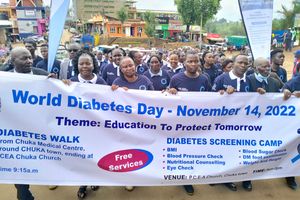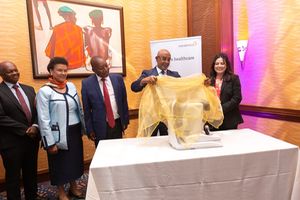Alarm over rising cases of undiagnosed diabetes

A doctor checks a patient's sugar level with a Glucometer. Researchers in Kenya are working on a simpler and faster way to predict when a patient has diabetes and hypertension (high blood pressure) by just taking photos of the eye.
What you need to know:
- Challenges in management of diabetes in Kenya include inadequate insulin supply, delayed screening, access to consumables such as syringes and glucometers and lack of education, which results from underfunding and inadequate human resources.
- WHO notes that Africa faces other stumbling blocks in the journey to eradicate diabetes such as lack of testing facilities and equipment, inadequate number of trained health personnel, poor access to health facilities and lack of awareness about diabetes.
- As a result, diabetes cases are projected to rise to 55 million from the current 24 million.
A new report by the World Health Organization (WHO) has shown that Africa tops the world in undiagnosed diabetes, raising the risk of severe illness and death. This is even as two-thirds of diabetic patients in Kenya remain undiagnosed, posing a big challenge to the health sector
WHO explains that in Kenya, three out of 10 people are likely to have diabetes and that the rate is likely to go up to four out of 10 by 2025. Because of low levels of awareness about the disease, the country’s progress towards fighting and eradicating diabetes becomes a more difficult task.
According to Afyacode, a medical health and wellness platform, cases of diabetes in Kenya have risen because of increased consumption of unhealthy dies, inadequate physical activity and obesity. In different counties, gender, age and presence of underlying conditions play a significant role on whether a person will become diabetic.
“In counties such as Isiolo, Othaya, Mukurweini, Thika and Meru, the diabetic ratio is 310,30,30,20 and four per 10,000. The most common type of diabetes is Type 2 diabetes in counties such as Isiolo, Meru and Thika with 98,96 and 94 per cent respectively,” says Afyacode.
Challenges in management of diabetes in Kenya include inadequate insulin supply, delayed screening, access to consumables such as syringes and glucometers and lack of education, which results from underfunding and inadequate human resources.
WHO notes that Africa faces other stumbling blocks in the journey to eradicate diabetes such as lack of testing facilities and equipment, inadequate number of trained health personnel, poor access to health facilities and lack of awareness about diabetes. As a result, diabetes cases are projected to rise to 55 million from the current 24 million.
“In the African region, premature deaths from diabetes (defined as deaths occurring before the age of 70) stand at 58 per cent, higher than the global average of 48 per cent, while the region’s age standardised death rate for diabetes is 48 per 100, 000 populations, more than double the global rate of 23 per 100, 000. In the region, only one in two people living with type 1 diabetes—the most common form of paediatric diabetes—has access to insulin treatment,” says WHO.
“Between 2011 and 2021, the region recorded a five-fold rise in type 1 diabetes among children and teenagers below 19 years, with cases surging from 4 per 1000 children to nearly 20 per 1000,” adds WHO.
WHO Regional Director for Africa, Dr Matshidiso Moeti, states that the lack of diagnosis is one of the greatest challenges that Africa grapples with.
“Without testing, diabetes becomes a silent killer. While countries face several barriers to tackling diabetes, the rising prevalence of the disease is a wakeup call to reinforce health care, improve diagnosis, access to life-saving diabetes medicines and prioritize diabetes as a major health challenge” explains Dr Moeti.
When the world celebrated the World Diabetes Day on November 14, whose theme was Access to Diabetes Care, policy makers were urged to increase awareness of the disease to help improve lives of those that live with diabetes worldwide.
While WHO asked for access to affordable insulin for those diagnosed with type 1 diabetes, and access to cholesterol lowering drugs for people aged 40 and above, the International Diabetes Federation said healthcare professionals must know how to detect and diagnose the condition early and provide the best possible care.
They also called for access to continuous education for people living with diabetes, which they said will help them to understand their condition and stay healthy and avoid complications.





